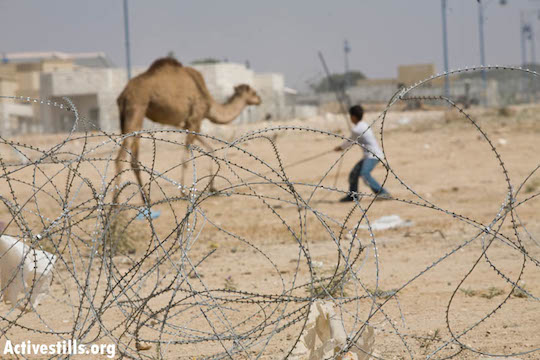The Israeli government approves a plan for five new settlements in the Negev/Naqab. Rights group says the plan, like Israel’s overall policy regarding its Bedouin citizens, is discriminatory.

The Israeli government on Sunday approved a plan for five new Jewish settlements to be built in the Negev (Naqab) in the south of Israel. The plan, which was submitted by Housing Minister Yoav Galant of Kulanu, threatens to displace thousands of Bedouin from their homes.
Two of the settlements are due to be built where Bedouin villages already exist, according to the Association for Civil Rights in Israel (ACRI). The new town of Daya is to be established on top of the unrecognized village of Katamat, which would displace its 1,500 Bedouin residents. Neve Gurion, meanwhile, is meant to be built on part of the land of the recognized village of Be’er Hadaj, home to 6,000 Bedouin citizens of Israel.
“This decision is a mere continuation of the government’s unequal planning policy, which attempts to move the inhabitants of Bedouin villages to urban or semi-urban settlements or existing townships, which are ranked at the bottom of the socio-economic ladder and are already under significant stress,” ACRI wrote in a statement on Sunday.
The government’s announcement comes just weeks after the unrecognized Bedouin village of Al-Araqib in the Negev was demolished for the 90th time. Israel’s continual razing of Al Araqib began in 2010, and the village has become a symbol of the ethnic discrimination that characterizes the state’s policies in the Negev.
Since the founding of the State of Israel, Jewish settlement in the Negev has been considered Zionism’s final frontier — an impression largely instilled by the vision of David Ben-Gurion, the country’s first prime minister. “It is in the Negev that the people of Israel will be tested,” Ben-Gurion said in the 1950s.
“Only with a united effort … will we accomplish the great mission of populating the wilderness and bringing it to flourish. This effort will determine the fate of the State of Israel and the standing of our people in the history of mankind.” Several years later, he reiterated: “The Negev is a great Zionist asset, with no substitute anywhere in the country.”

Sixty years later, the wheels of Ben-Gurion’s dream have been firmly set in motion. The Prawer Plan, a government framework for forcibly moving thousands of Bedouin living in unrecognized villages in the Negev into impoverished townships, seemed dead in the water until the last elections. During coalition negotiations, the plan was resuscitated as a bargaining chip between the Likud and Jewish Home, with Naftali Bennett leveraging its revival as a condition for joining the government.
Israeli is also expropriating large tracts of Bedouin land – either for “greening” (i.e. planting forests on top of the ruins of demolished villages) under the auspices of the JNF, or for building new Jewish settlements on top of Bedouin towns, as is the state’s wont.
Israel has systematically refused to recognize many of the Negev villages and towns in which Bedouin citizens live, meaning that they have no connections to electricity, water or sewage infrastructure, and are in constant danger of demolition. The new suburban settlements the state builds in the Negev are generally designated for Jews, whereas Bedouin are encouraged to move to Bedouin-only townships that lack economic opportunities and are not designed with Bedouin social structures in mind.
The Negev village of Umm el-Hiran is perhaps the most blatant example of how the state hopes to displace Bedouin citizens for the benefit of Jewish citizens. The Israeli Supreme Court recently upheld plans to demolish Umm el-Hiran and build a Jewish town, named Hiran, in its place. Umm el-Hiran’s Bedouin residents would be forcibly relocated to the nearby township of Hura, according to the state’s plans.
Adjacent to Umm el-Hiran is the village of Atir, which also faces destruction — so that the JNF can expand a manmade forest, named Yatir, over its ruins. (Notice the pattern of only slightly altering names to Hebraize them?)
Housing Minister Galant on Sunday evoked Ben-Gurion when praising the government’s passing of his plan [Heb]: “It is our responsibility to settle the Negev … to turn it into a desirable and thriving area, in keeping with the Zionist vision,” he said.


